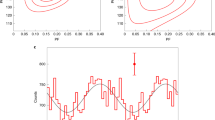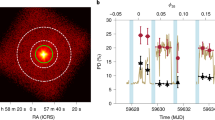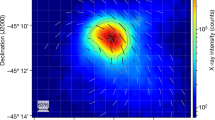Abstract
The Crab pulsar and its nebula are among the most studied astrophysical systems, and constitute one of the most promising environments where high-energy processes and particle acceleration can be investigated. They are the only objects for which significant X-ray polarization was detected in the past. Here we present the Imaging X-ray Polarimetry Explorer (IXPE) observation of the Crab pulsar and nebula. The total pulsar pulsed emission in the [2–8] keV energy range is unpolarized. Significant polarization up to 15% is detected in the core of the main peak. The nebula has a total space integrated polarized degree of 20% and polarization angle of 145°. The polarized maps show a large variation in the local polarization, and regions with a polarized degree up to 45–50%. The polarization pattern suggests a predominantly toroidal magnetic field. Our findings for the pulsar are inconsistent with most inner magnetospheric models, and suggest emission is more likely to come from the wind region. For the nebula, the polarization map suggests a patchy distribution of turbulence, uncorrelated with the intensity, in contrast with simple expectations from numerical models.
This is a preview of subscription content, access via your institution
Access options
Access Nature and 54 other Nature Portfolio journals
Get Nature+, our best-value online-access subscription
$29.99 / 30 days
cancel any time
Subscribe to this journal
Receive 12 digital issues and online access to articles
$119.00 per year
only $9.92 per issue
Buy this article
- Purchase on Springer Link
- Instant access to full article PDF
Prices may be subject to local taxes which are calculated during checkout




Similar content being viewed by others
Data availability
Data from the Crab PSR and nebula observation are available in the HEASARC IXPE Data Archive (https://heasarc.gsfc.nasa.gov/docs/ixpe/archive/). Additional data are available in the Supplementary Information and from figshare at https://doi.org/10.6084/m9.figshare.22203163. Source data are provided with this paper.
Code availability
The ixpeobssim software and documentation can be downloaded at https://github.com/lucabaldini/ixpeobssim. Other information supporting the findings of this study, and specific data-reduction pipelines, are available from the corresponding author upon request.
References
Gaensler, B. M. & Slane, P. O. The evolution and structure of pulsar wind nebulae. Annu. Rev. Astron. Astrophys. 44, 17–47 (2006).
Hester, J. J. The Crab nebula: an astrophysical chimera. Annu. Rev. Astron. Astrophys. 46, 127–155 (2008).
Weisskopf, M. C., Silver, E. H., Kestenbaum, H. L., Long, K. S. & Novick, R. A precision measurement of the X-ray polarization of the Crab nebula without pulsar contamination. Astrophys. J. Lett. 220, L117–L121 (1978).
Forot, M., Laurent, P., Grenier, I. A., Gouiffès, C. & Lebrun, F. Polarization of the Crab pulsar and nebula as observed by the INTEGRAL/IBIS telescope. Astrophys. J. Lett. 688, L29–L32 (2008).
Moran, P. et al. Optical polarimetry of the inner Crab nebula and pulsar. Mon. Not. R. Astron. Soc. 433, 2564–2575 (2013).
Chauvin, M., Roques, J. P., Clark, D. J. & Jourdain, E. Polarimetry in the hard X-ray domain with INTEGRAL SPI. Astrophys. J. 769, 137 (2013).
Chauvin, M. et al. Shedding new light on the Crab with polarized X-rays. Sci. Rep. 7, 7816 (2017).
Vadawale, S. V. et al. Phase-resolved X-ray polarimetry of the Crab pulsar with the AstroSat CZT imager. Nat. Astron. 2, 50–55 (2018).
Feng, H. et al. Re-detection and a possible time variation of soft X-ray polarization from the Crab. Nat. Astron. 4, 511–516 (2020).
Long, X. et al. X-ray polarimetry of the Crab nebula with polarlight: polarization recovery after the glitch and a secular position angle variation. Astrophys. J. Lett. 912, L28 (2021).
Li, H.-C. et al. Gamma-ray polarimetry of the Crab pulsar observed by POLAR. Mon. Not. R. Astron. Soc. 512, 2827–2840 (2022).
Trimble, V. The distance to the Crab nebula and NP 0532. Publ. Astron. Soc. Pac. 85, 579 (1973).
Kargaltsev, O. et al. in 40 Years of Pulsars: Millisecond Pulsars, Magnetars and More Vol. 983 (eds Bassa, C. G. et al.) 171–185 (American Institute of Physics, 2008).
Mori, K. et al. Spatial variation of the X-ray spectrum of the Crab nebula. Astrophys. J. 609, 186–193 (2004).
Hester, J. J. et al. WFPC2 studies of the Crab nebula. I. HST and ROSAT imaging of the synchrotron nebula. Astrophys. J. 448, 240–263 (1995).
Weisskopf, M. C. et al. Discovery of spatial and spectral structure in the X-ray emission from the Crab nebula. Astrophys. J. Lett. 536, L81–L84 (2000).
Aumont, J. et al. Measurement of the Crab nebula polarization at 90 GHz as a calibrator for CMB experiments. Astron. Astrophys. 514, A70 (2010).
Moran, P. et al. Optical polarimetry of the inner Crab nebula and pulsar. Mon. Not. R. Astron. Soc. 433, 2564–2575 (2013).
Zanin, R. in Modelling Pulsar Wind Nebulae Vol. 446 (ed. Torres, D. F.) 101–133 (Springer, 2017).
Kaaret, P. et al. Chandra observations of the Young pulsar PSR B0540-69. Astrophys. J. 546, 1159–1167 (2001).
Massaro, E., Campana, R., Cusumano, G. & Mineo, T. The optical to γ-ray emission of the Crab pulsar: a multicomponent model. Astron. Astrophys. 459, 859–870 (2006).
Weisskopf, M. C. et al. Chandra phase-resolved X-ray spectroscopy of the Crab pulsar. Astrophys. J. 743, 139 (2011).
Ge, M. Y. et al. X-ray phase-resolved spectroscopy of PSRs B0531+21, B1509-58, and B0540-69 with RXTE. Astrophys. J. Suppl. Ser. 199, 32 (2012).
Vivekanand, M. Phase-resolved spectrum of the Crab pulsar from NICER. Astron. Astrophys. 649, A140 (2021).
Słowikowska, A., Kanbach, G., Kramer, M. & Stefanescu, A. Optical polarization of the Crab pulsar: precision measurements and comparison to the radio emission. Mon. Not. R. Astron. Soc. 397, 103–123 (2009).
Weisskopf, M. The Imaging X-ray Polarimetry Explorer (IXPE) mission overview, in the AAS High Energy Astrophysics Division meeting. Bulletin Am. Astr. Soc. 54, 301.01 (2022).
Weisskopf, M. C. et al. Imaging X-ray Polarimetry Explorer: prelaunch. J. Astron. Telesc. Instrum. Syst. 8, 026002 (2022).
Pesce-Rollins, M., Lalla, N. D., Omodei, N. & Baldini, L. An observation-simulation and analysis framework for the Imaging X-ray Polarimetry Explorer (IXPE). Nucl. Inst. Meth. Phys. Res. A 936, 224–226 (2019).
Baldini, L. et al. ixpeobssim: a simulation and analysis framework for the Imaging X-ray Polarimetry Explorer. SoftwareX 19, 101194 (2022).
Tennant, A. F. et al. Discovery of X-ray emission from the crab pulsar at pulse minimum. Astrophys. J. Lett. 554, L173–L176 (2001).
Ng, C.-Y. & Romani, R. W. Fitting pulsar wind tori. Astrophys. J. 601, 479–484 (2004).
Schweizer, T. et al. Characterization of the optical and X-ray properties of the north-western wisps in the Crab nebula. Mon. Not. R. Astron. Soc. 433, 3325–3335 (2013).
Dyks, J. & Harding, A. K. Rotational sweepback of magnetic field lines in geometric models of pulsar radio emission. Astrophys. J. 614, 869–880 (2004).
Pétri, J. Phase-resolved polarization properties of the pulsar striped wind synchrotron emission. Mon. Not. R. Astron. Soc. 434, 2636–2644 (2013).
Cerutti, B., Mortier, J. & Philippov, A. A. Polarized synchrotron emission from the equatorial current sheet in gamma-ray pulsars. Mon. Not. R. Astron. Soc. 463, L89–L93 (2016).
Harding, A. K. & Kalapotharakos, C. Multiwavelength polarization of rotation-powered pulsars. Astrophys. J. 840, 73 (2017).
Cerutti, B., Philippov, A. A. & Dubus, G. Dissipation of the striped pulsar wind and non-thermal particle acceleration: 3D PIC simulations. Astron. Astrophys. 642, A204 (2020).
Bucciantini, N., del Zanna, L., Amato, E. & Volpi, D. Polarization in the inner region of pulsar wind nebulae. Astron. Astrophys. 443, 519–524 (2005).
Nakamura, Y. & Shibata, S. Polarization of the Crab nebula with disordered magnetic components. Mon. Not. R. Astron. Soc. 381, 1489–1498 (2007).
Porth, O., Komissarov, S. S. & Keppens, R. Three-dimensional magnetohydrodynamic simulations of the Crab nebula. Mon. Not. R. Astron. Soc. 438, 278–306 (2014).
Olmi, B., Del Zanna, L., Amato, E., Bucciantini, N. & Mignone, A. Multi-D magnetohydrodynamic modelling of pulsar wind nebulae: recent progress and open questions. J. Plas. Phys. 82, 635820601 (2016).
Bucciantini, N., Bandiera, R., Olmi, B. & Del Zanna, L. Modeling the effect of small-scale magnetic turbulence on the X-ray properties of pulsar wind nebulae. Mon. Not. R. Astron. Soc. 470, 4066–4074 (2017).
Bandiera, R. & Petruk, O. Radio polarization maps of shell-type supernova remnants—I. Effects of a random magnetic field component and thin-shell models. Mon. Not. R. Astron. Soc. 459, 178–198 (2016).
Bucciantini, N., Amato, E., Bandiera, R., Blondin, J. M. & Del Zanna, L. Magnetic Rayleigh-Taylor instability for pulsar wind nebulae in expanding supernova remnants. Astron. Astrophys. 423, 253–265 (2004).
Ferrazzoli, R. et al. In-flight calibration system of Imaging X-ray Polarimetry Explorer. J. Astron. Telesc. Instrum. Syst. 6, 048002 (2020).
Lyne, A. G., Pritchard, R. S. & Graham-Smith, F. 23 years of Crab pulsar rotational history. Mon. Not. R. Astron. Soc. 265, 1003–1012 (1993).
Bachetti, M. HENDRICS: High ENergy Data Reduction Interface from the Command Shell. Record ascl:1805.019 (Astrophysics Source Code Library, 2018).
Hobbs, G. B., Edwards, R. T. & Manchester, R. N. TEMPO2, a new pulsar-timing package—I. An overview. Mon. Not. R. Astron. Soc. 369, 655–672 (2006).
Luo, J. et al. PINT: a modern software package for pulsar timing. Astrophys. J. 911, 45 (2021).
Kuiper, L., Hermsen, W., Walter, R. & Foschini, L. Absolute timing with IBIS, SPI and JEM-X aboard INTEGRAL. Crab main-pulse arrival times in radio, X-rays and high-energy gamma -rays. Astron. Astrophys. 411, L31–L36 (2003).
Acknowledgements
The IXPE is a joint US and Italian mission. The US contribution is supported by NASA and led and managed by its Marshall Space Flight Center (MSFC), with industry partner Ball Aerospace (contract no. NNM15AA18C). The Italian contribution is supported by the Italian Space Agency (Agenzia Spaziale Italiana, ASI) through contract no. ASI-OHBI-2017-12-I.0, agreement nos. ASI-INAF-2017-12-H0 and ASI-INFN-2017.13-H0, and its Space Science Data Center (SSDC) with agreement nos. ASI-INAF-2022-14-HH.0 and ASI-INFN 2021-43-HH.0, and by the Istituto Nazionale di Astrofisica (INAF) and the Istituto Nazionale di Fisica Nucleare (INFN) in Italy. This research used data products provided by the IXPE Team (MSFC, SSDC, INAF and INFN) and distributed with additional software tools by the High-Energy Astrophysics Science Archive Research Center (HEASARC), at NASA Goddard Space Flight Center (GSFC). The research at Boston University was supported in part by National Science Foundation grant no. AST-2108622. Part of the French contributions is supported by the Scientific Research National Center (CNRS) and the French spatial agency (CNES). I.A. acknowledges financial support from the Spanish ‘Ministerio de Ciencia e Innovación’ (grant no. MCIN/AEI/ 10.13039/501100011033) through the Center of Excellence Severo Ochoa award for the Instituto de Astrofísica de Andalucía-CSIC (grant no. CEX2021-001131-S), and through grant nos. PID2019-107847RB-C44 and PID2022-139117NB-C44. C.-Y.N. is supported by a GRF grant from the Hong Kong Government under no. HKU 17305419. N.B. was supported by the INAF MiniGrant ‘PWNnumpol - Numerical Studies of Pulsar Wind Nebulae in The Light of IXPE’. J.H. acknowledges support from the Natural Sciences and Engineering Research Council of Canada through a Discovery Grant, the Canadian Space Agency through the co-investigator grant programme, and computational resources and services provided by Compute Canada, Advanced Research Computing at the University of British Columbia, and the SciServer science platform. S.G. and E.W. were supported by grant nos. JSPS KAKENHI JP 19H00696 and 22K14068.
Author information
Authors and Affiliations
Contributions
N.B. led the data analysis and the writing of the paper. R.F., M.B., J.R., L.P. and F.M. contributed to data analysis and data calibration. N.D.L., C.S., N.O., T.K., T.M., S.G. and E.W. contributed to data analysis and results interpretation. M.C.W., M.N., S.S., E.D.O.W., F.X., J.H., R.W.R., P.T., A.P. and H.L.M. contributed to text revision and data interpretation. L.B. and M.P.-R. contributed to software development. The remaining members of the IXPE collaboration contributed to the design of the mission, to the calibration of the instrument, to defining its science case and to the planning of the observations. All authors provided inputs and comments on the paper.
Corresponding author
Ethics declarations
Competing interests
The authors declare no competing interests.
Peer review
Peer review information
Nature Astronomy thanks Santosh Vadawale and the other, anonymous, reviewer(s) for their contribution to the peer review of this work.
Additional information
Publisher’s note Springer Nature remains neutral with regard to jurisdictional claims in published maps and institutional affiliations.
Supplementary information
Supplementary Information
Supplementary Figs. 1–5 and Tables 1 and 2.
Supplementary Data 1
Chandra count map (Fig. 2).
Supplementary Data 2
IXPE count map (Fig. 2).
Supplementary Data 3
IXPE OP count map (Fig. 2).
Supplementary Data 4
IXPE PD (Fig. 4).
Supplementary Data 5
IXPE intensity (Fig. 4).
Supplementary Data 6
IXPE significance (Supplementary Fig. 3).
Supplementary Data 7
IXPE Q/I (Supplementary Fig. 4).
Supplementary Data 8
IXPE U/I (Supplementary Fig. 4).
Supplementary Data 9
Data of Supplementary Fig. 1.
Supplementary Data 10
Data of Supplementary Fig. 5.
Source data
Source Data Fig. 1
Data already reported in Table 1 of the main text.
Source Data Fig. 2
Images as data tables. Fits file images also provided as Supplementary Data and/or figshare.
Source Data Fig. 3
Polarization data already reported in Supplementary Table 2. We provide also the ASCII table for the light-curve and optical data.
Source Data Fig. 4
Images as data tables (polarization directions as list). Fits file images also provided as Supplementary Data and/or figshare.
Rights and permissions
Springer Nature or its licensor (e.g. a society or other partner) holds exclusive rights to this article under a publishing agreement with the author(s) or other rightsholder(s); author self-archiving of the accepted manuscript version of this article is solely governed by the terms of such publishing agreement and applicable law.
About this article
Cite this article
Bucciantini, N., Ferrazzoli, R., Bachetti, M. et al. Simultaneous space and phase resolved X-ray polarimetry of the Crab pulsar and nebula. Nat Astron 7, 602–610 (2023). https://doi.org/10.1038/s41550-023-01936-8
Received:
Accepted:
Published:
Issue Date:
DOI: https://doi.org/10.1038/s41550-023-01936-8



